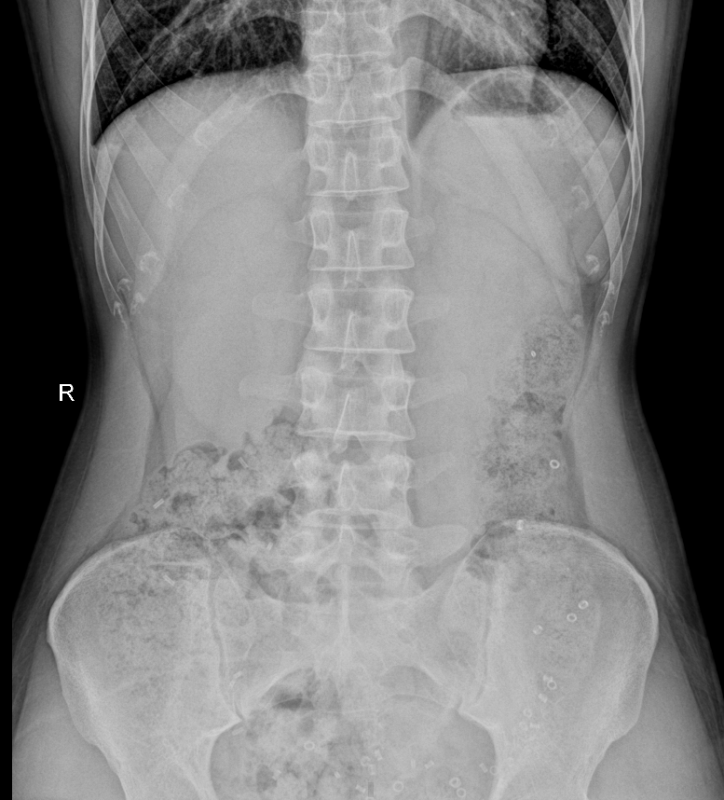Research objectives: Xác định tỉ lệ rối loạn nhu động đại trực tràng bằng viên nang cản quang và một số yếu tố liên quan ở người bệnh táo bón tại Trung tâm Tiêu hóa – Gan mật, Bệnh viện Bạch Mai.
1. Introduction
Constipation is a common problem in the community, affecting approximately 20% of the population, with women accounting for approximately 80-90%. It is a distressing condition that reduces quality of life and can lead to many complications if not treated promptly. In this patient group, structured management for effective treatment is important, as the majority of patients do not respond to initial treatments such as dietary changes and the use of conventional laxatives.
One of the important factors that needs to be assessed is colonic transit time, to determine whether the colon is functioning normally or is slowed. However, this assessment based on patient description is often difficult and not sufficiently accurate. Therefore, when initial treatment is unsuccessful, it is necessary to consider the use of functional investigation methods, including colonic transit time assessment by contrast capsule.
2. Transit Capsules – Pellets
a. Definition Transit-Pellets consist of small radiopaque white markers, made from Barium Sulphate (BaSO₄), encapsulated inside a hard shell HPMC (Hydroxypropyl Methylcellulose) capsule. The capsule contains no gelatin, in accordance with pharmaceutical standards. The purpose of the capsule is to transport the markers into the stomach, where they dissolve and pass through the digestive system, eventually being excreted in the stool.
b. Safety Transit-Pellets are smaller than 8mm in size and come in two shapes: tubular and ring. Markers with specific gravity between 1.2 and 1.6 have been tested and proven to be effective and safe. The device has been shown to be safe and effective compared to standard devices (predicate devices) in measuring colonic transit time, regardless of marker shape.
The use of barium sulphate contrast markers to measure colonic transit time has been practiced for over 45 years. Barium sulphate is a radiopaque contrast agent, dense enough to resist X-rays passing through it, and therefore can be easily seen on X-ray images. In clinical studies, the efficacy and safety of the device for measuring colonic transit time have been confirmed, particularly in a study of 1054 children and adolescents, which showed no adverse events related to the device in any of the studies.
c. Application
• If colonic transit time is delayed, consider stepping up constipation treatment with a change in laxatives, motility stimulants, etc.
• If the patient has severe constipation symptoms but completely normal transit time, there is a high probability that the patient has altered sensitivity as in irritable bowel syndrome (IBS) and therapy should be adjusted accordingly.
• In a small number of patients with colonic inertia, surgery may be considered, but if colonic transit time in the cecum-ascending colon is normal, surgery is not indicated.
• If transit time through the rectum and sigmoid colon is delayed, the possibility of outlet obstruction, including pelvic floor dysfunction, should be considered.
d. Practical instructions

Image 1: Quick start guide to Transit – Pellets colon motility assessment capsules
Colonic transit time was calculated as the average mouth-to-anus transit time (OATT, mouth-to-anus) of the daily ingested signal doses. Since colonic transit time accounts for the majority of mouth-to-anus transit time, OATT was used as an index to measure
colonic transit time. Transit time is equivalent to the number of daily doses of markers remaining in the body. With a daily dose of ten markers, transit time is calculated by the formula:
Mouth-to-anus transit time (OATT) =
| Gender | Ascending colon | Transverse colon | Descending colon | Sigmoid colon and rectum | Total |
| Female | |||||
| Nữ |
Table 1: Transit time results in each region of the colon
3. Clinical case
Phạm Văn.Q 31 tuổi giới tính nam
Medical history: No previous medical history.
Bệnh sử: Đại tiện phân rắn cục, 3 ngày/ lần, gắng sức nhiều trong mỗi lần đại tiện, đôi lúc phải sử dụng thuốc nhuận tràng
Diet:
- – 4-5 bát cơm trắng/ngày, ít ăn đồ xào, đồ dầu mỡ, ăn đồ luộc. Ăn nhiều rau cải bắp ~ 1 bát/con, không rượu bia, không thuốc lá, không café, không ăn đồ ăn chế biến sẵn
- – Drink 1-1.5l/day.

The patient underwent colonic transit time measurement using Transit Pellets.
Image 2: Radiopaque image of Transit Pellets on X-ray image on day 7
With the above results, we counted 24 contrast materials and evaluated OTTA = 2.4 days. The patient is male so this result would be equivalent to the patient's slightly weak peristalsis. However, as we can see, the contrast material is mainly concentrated in the sigmoid colon - rectum, suggesting a disorder of the patient's pelvic floor. The patient was recommended to perform other functional tests such as anorectal pressure measurement.
4. Conclusion
A study of colonic motility in patients with constipation using contrast capsules at the Gastrointestinal - Hepatobiliary Center, Bach Mai Hospital has shown that the use of contrast capsules (Transit-Pellets) is a useful and safe tool in assessing colonic transit time in patients with constipation. The results of the studies showed that a significant proportion of patients had colonic motility disorders, especially in cases with persistent constipation symptoms or unresponsive to initial treatment.
This method not only helps determine the status of colonic transit but also supports doctors in making appropriate treatment decisions, from adjusting diet, using laxatives, to investigating factors related to pelvic floor dysfunction or even surgical measures when necessary. Measuring colonic transit time with contrast capsules is an important step forward in optimizing the diagnosis and treatment of constipation, contributing to improving the quality of life for patients.
